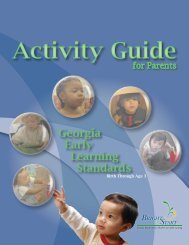Georgia's Pre-K Program - FPG Child Development Institute ...
Georgia's Pre-K Program - FPG Child Development Institute ...
Georgia's Pre-K Program - FPG Child Development Institute ...
You also want an ePaper? Increase the reach of your titles
YUMPU automatically turns print PDFs into web optimized ePapers that Google loves.
Georgia Study of Early Care and Education: Findings from Georgia’s <strong>Pre</strong>-K <strong>Program</strong><br />
Throughout this report, data are presented separately for centers and schools because<br />
of the different response rates in these two groups. However, the study and sampling<br />
plan were not designed to examine differences between Georgia’s <strong>Pre</strong>-K <strong>Program</strong> in<br />
centers and schools, so statistical comparisons between the groups are not presented.<br />
Classroom Selection<br />
For each participating program, we randomly selected one, two, or three classrooms<br />
to visit, depending on the ages served by the program and whether they participated<br />
in Georgia’s <strong>Pre</strong>-K. If the program included infant/toddler classes (serving children<br />
less than 2½ years old), we randomly selected one of those. If the program included<br />
classrooms serving preschoolers (ages 2½ to 5, not in kindergarten), we randomly<br />
selected one of those. If the program participated in Georgia’s <strong>Pre</strong>-K, we also<br />
randomly selected one Georgia’s <strong>Pre</strong>-K class. (For the remainder of this report,<br />
“preschool” refers to classes that are not part of Georgia’s <strong>Pre</strong>-K <strong>Program</strong> and serve<br />
children between 2½ years and 5 years who are not in kindergarten and “pre-k” refers<br />
to Georgia’s <strong>Pre</strong>-K classes). If a class was selected but the lead teacher was absent (n =<br />
22) or did not want to participate (n = 3), a replacement class of the same type within<br />
the same program was selected instead. Table 1 shows the number of classrooms<br />
visited for each type of classroom configuration. In public schools, we did not visit any<br />
classrooms other than Georgia’s <strong>Pre</strong>-K. This report presents findings from Georgia’s<br />
<strong>Pre</strong>-K classrooms in child care centers and schools. Information about infant/toddler<br />
classrooms and preschool classrooms that are not part of Georgia’s <strong>Pre</strong>-K <strong>Program</strong> is<br />
presented in a companion report, Georgia Study of Early Care and Education: <strong>Child</strong> Care<br />
Center Findings.<br />
Table 1. Classroom Visits by <strong>Program</strong> Type<br />
<strong>Program</strong> Type <strong>Program</strong>s<br />
Infant/<br />
Toddler<br />
Classes<br />
Number of<br />
<strong>Pre</strong>school<br />
Classes<br />
GA<br />
<strong>Pre</strong>-K<br />
Classes<br />
Total<br />
Classes<br />
Infant/Toddler & <strong>Pre</strong>school 49 49 49 0 98<br />
Infant/Toddler, <strong>Pre</strong>school, &<br />
Georgia’s <strong>Pre</strong>-K<br />
48 48 48 48 144<br />
<strong>Pre</strong>school Only 10 0 10 0 10<br />
<strong>Pre</strong>school & Georgia’s <strong>Pre</strong>-K 2 0 2 2 4<br />
Georgia’s <strong>Pre</strong>-K Only a 64 0 0 64 64<br />
TOTALS 173 97 109 114 320<br />
a. Of the 64 programs that have only Georgia’s <strong>Pre</strong>-K, 61 were in public schools. Of the other three, one was<br />
at a licensed center and two were child care facilities that were exempt from Georgia’s Early Care and Learning<br />
licensing. All three of these programs are treated as “centers” for purposes of this report.<br />
3
















